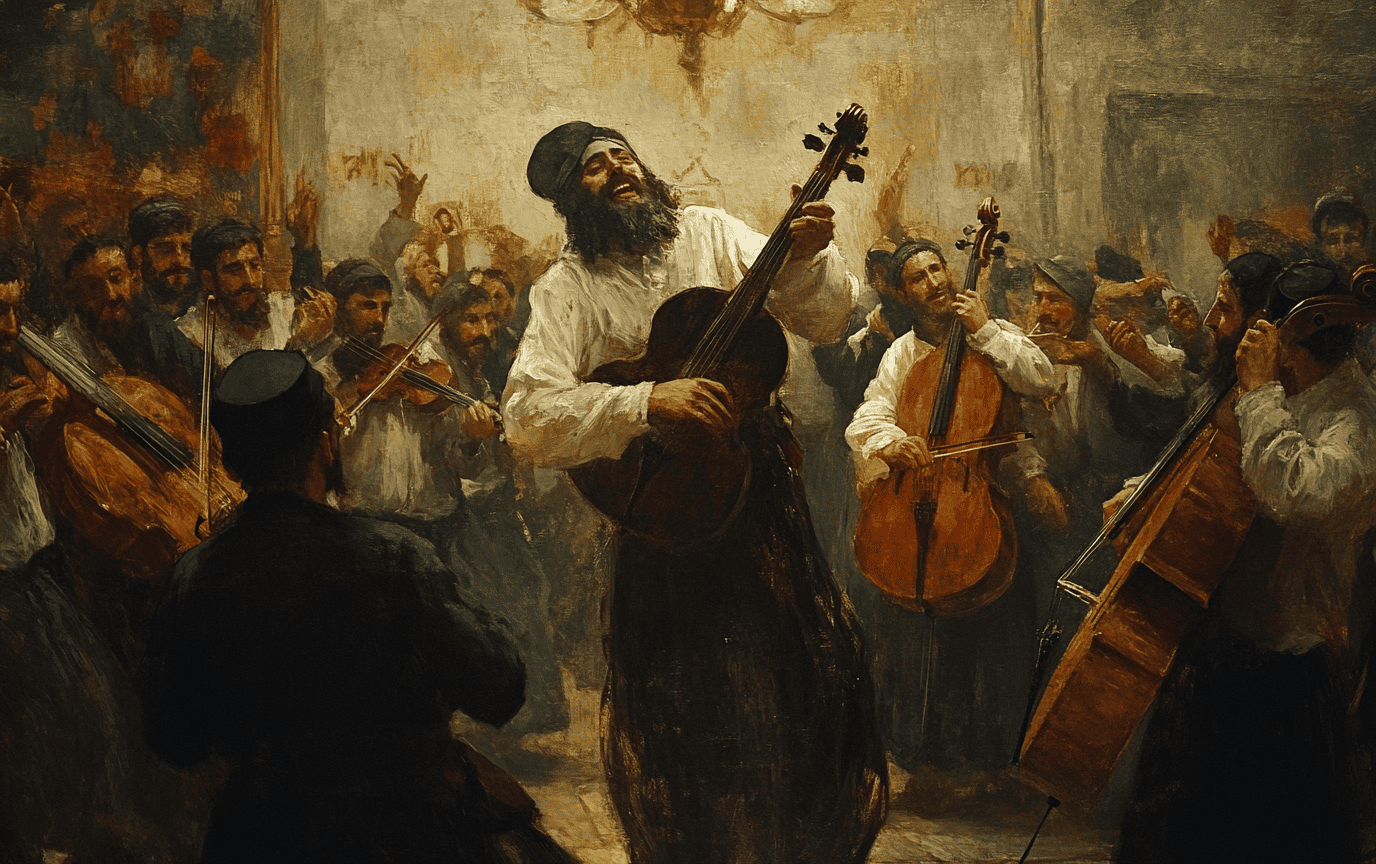The Role of Music in Jewish Culture
Music is the heartbeat of Jewish culture, resonating through the long corridors of history and spirituality, connecting past and present. It weaves unwavering threads of tradition and innovation, wrapping communities in a vibrant tapestry of sound and emotion. As you walk through the various facets of Jewish life, music serves as a bridge, linking generations and forging communal identities.
Historical Roots of Jewish Music
Imagine a temple in Jerusalem, the air thick with incense, and the harmonious blend of lyres, harps, and trumpets enveloping the gathering. This is where it begins—an orchestra dedicated to worship, making music a sacred act meant to draw the community closer to the divine. These early forms of music proliferated through the centuries, continuing even after the destruction of the Second Temple in 70 AD, when Jewish music found sanctuary in the hearts of synagogues.
Vocal traditions rose to prominence, and the use of musical modes known as nusach became integral, setting the tone for prayers and rituals. Each note carried the weight of centuries, etched in the communal memory, a reflection of resilience and faith. Like a gentle caress or a storm’s raging embrace, it served to lift spirits and draw the community together.
Cultural Influences on Jewish Music
Take a moment to appreciate the kaleidoscope of influences that shaped Jewish music. It has never existed in isolation; rather, it is a living entity that thrives on cultural exchanges. The melodic structures brought by Islamic Spain infused vitality into liturgical pieces, while the vibrant folk traditions of Eastern Europe sprinkled joy and heartbreak into popular songs.
Each community across the globe—a tapestry of voices—intertwined stories and sounds. From the East European klezmer to the soulful melodies of the Sephardic tradition, Jewish music reflects the triumphs and tribulations, hopes and dreams of a diverse people. It is a narrative told through notes, a testament to the survival of an identity fostered amid adversity.
Music in Jewish Prayer and Ritual
Music is more than sound; it is the spiritual remedy that binds the flock. The Talmud equates music to prayer, drawing lines of connection between the material and immaterial worlds, allowing individuals to reach into the divine. In the hush of a moment before prayer, one can hear whispers—echoes of souls seeking solace.
As melodies rise, hearts ignite. In Israel, congregants sway gently, immersed in the ancient rhythms and contemporary beats, transforming communal worship into transcendent experiences. When the heart flourishes and the lips sing, a miraculous elevation occurs—a dance of spirits filling the space, where every note holds the potential for revelation.
And how profound this truth is, illustrated in the stories of our forefathers: Moses leading his people in song after the crossing of the Red Sea, or David strumming his harp while shepherding flocks, basking in divine presence. Music transforms life into something sacred; it resonates in the unison of voices, healing wounds that can only be seen in silence.
Types of Jewish Music
With its vast and varied landscape, Jewish music encompasses a multitude of forms. At its core, liturgical piyyutim serve as poetic vessels for prayer. These lyrical prayers, infused with deep spirituality, are often set against melodies that evoke the very essence of faith. Picture a gathering where voices float around, and suddenly, an entire congregation becomes one.
Neginot, the melodic cantillation marks, even carry ancient emotions. With every syllable, communal identity is both preserved and expressed. They embody a direct connection to the past, acting as custodians for the collective memory while ensuring its continuance in the ever-evolving realm of sound.
The secular melodies, bursting from the hearts of the people, transform not just celebrations but everyday lives as well. Klezmer, with its raucous energy, invites listeners to celebrate life, evoking joy and laughter through a frenzied fiddle or a clarinet that seems to weep and laugh in the same breath. Each song tells a story; each note is infused with the spirit of the moment, breathing life into a cherished tradition.
The Role of Music in Jewish Community
A chorus of voices—this is the spirit of community. Music is a communal act, engendering fellowship, shared memories, and an embedded sense of belonging. As families gather to celebrate, be it Passover or Hanukkah, laughter and song intertwine—a harmonious blend of generations bridging past and present.
Through song, stories are told, history is passed down, and the essence of togetherness permeates every festivity. Imagine the scene, where modern youth and their elders collide in rhythm; they are transported across time, their differences dissolved in the strains of familiar melodies. It is here that Jewish music thrives, reaffirming bonds and nurturing cultural heritage.
When the clarinet screeches and the accordion dances through the air at a wedding, it’s a reminder that love flourishes through shared moments, enchanted by klezmer tunes. It becomes a space where joy is palpable, and every eye glistens with emotion—the celebration of community wrapped tightly in musical embrace.
Modern Jewish Music
The evolution of Jewish music thrives even today, infused with modern sensibilities. Artists like Steve Reich and Srul Irving Glick push the boundaries between classical prestige and contemporary innovation, experimenting while respecting their cultural roots. They breathe new life into ancient legacies, bridging the time-worn past to the vibrant present.
Projects like the ARC Ensemble’s “Music in Exile” shine in the spotlight. They gather works from composers who faced persecution, unearthing hidden gems that speak volumes of resilience. From these collaborations erupts a celebration of diversity—melodies merging to create something new, reminiscent of a rich historical heritage—alive and breathing in today’s world.
The digital age is equally important in reshaping Jewish music. With numerous platforms accessible, Jewish melodies reach avid listeners, allowing the fusion of tradition and innovation to flourish worldwide. A sweet lullaby sung in a modest home may ripple outward, echoing through hearts miles away.
Discovering new artists and collecting forgotten memories is just a click away. Online resources transcend geographic boundaries, allowing music to flow freely, connecting Jewish communities across oceans—a vibrant reminder of shared experiences amid disparate realities.
Conclusion
The role of music in Jewish culture is layered and profound, serving as a bridge between tradition and contemporary realities, spirituality and community, connection and identity. With every note, it entwines across the textures of life, fostering communal ties and enriching spiritual lives.
From the ancient halls of temples to contemporary celebrations, music continues to be an indispensable part of Jewish culture. It thrives, breathing life into rituals, shaping identities, and echoing across generations. As you navigate through life’s journey, allow the melodies of the Jewish experience to resonate within you, weaving dimensions of celebration, spirituality, and shared history into your own narrative. Enjoy the offerings of this vibrant culture, where sound speaks louder than words and melodies transform life’s simplest moments into extraordinary memories.
Interested in more insightful reads? Check out our Travel Tips section for the latest advice. For lifestyle inspiration, explore our Lifestyle category, and dive into amazing destinations at Destinations. Don’t forget to connect with us on YouTube, or follow our adventures on Instagram and Pinterest.













